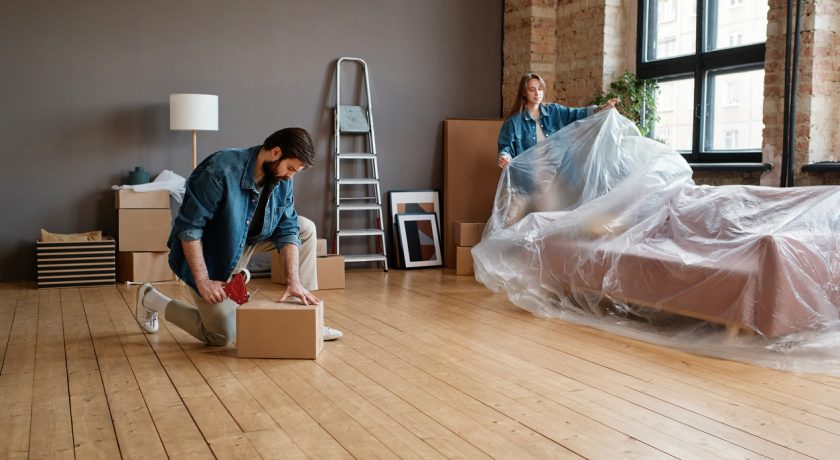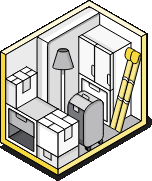How to Wrap Furniture For Moving

When it comes to moving furniture, there’s a lot more to it than just simply shoving it into the back of a moving van. After all, furniture comes in different shapes, sizes, and materials, so you can’t use the same method for everything. That’s why you need careful planning to ensure your furniture remains undamaged and ready for your new home.
Don’t worry, though. If you have the right materials and wrap your items properly, they can stay in great condition during the move. Here’s how to wrap furniture for moving.
1. Gather Packing Supplies
Furniture should not be placed in a truck without protective wrapping; otherwise, it’s much more likely to become damaged during the move. The safe delivery of your furniture depends on using the right wrapping and packing materials, so it’s important to choose them carefully. Luckily, you can easily find many of the following items to help protect furniture locally or online.
- Moving blankets
- Bubble wrap
- Stretchable plastic wrap
- Packing tape
- Packing paper
- Furniture pads or covers
- Corrugated cardboard sheets
- Sealable plastic bags
- Sofa and mattress covers
2. Prepare Your Furniture
There are a few things you need to do when preparing your furniture for a move.
Clean Furniture
When moving large furniture, your first thought is likely to disassemble it. However, before you begin disassembling, you’ll want to clean and dust your furniture thoroughly using a soft cloth. It might seem unnecessary, but dust and dirt can scratch surfaces during the move.
Take Photographs
Take photos and videos of your furniture before any professional movers arrive to document its condition. If you’re moving on your own, these images will also help you with arranging and reassembling your furniture in your new place.
Remove Smaller Pieces
Once you’ve finished cleaning, consider removing any knobs, wheels, or handles from your furniture. This will help prevent them from catching on or bumping into other furniture and causing damage. Then, remove any belongings from inside the furniture for packing and take out any drawers to help make heavy furniture lighter for the move.
Disassemble Large Items
Finally, take your furniture apart. Remove pieces like legs from tables and couches and disassemble any bed frames. A good rule of thumb is: if you can safely dismantle a piece of furniture, do it. This will make the furniture easier to move and reduce the chance of damage from hitting walls or door frames since it’s now in smaller pieces and easier to move, lift, and load on and off the moving truck.
Remember to label all the parts and place any small pieces of hardware inside a labelled plastic bag to make reassembling easier later!
3. Wrap Your Furniture for Moving
There are many steps and methods to wrapping furniture for moving. It all depends on what type of furniture you need to move. Here, we’ll break down different approaches based on the type of furniture. Also, don’t forget to label all wrapped furniture so you know what’s inside and what room it needs to go in when you get there.
Couches
If your couch is made of light fabric like cotton or linen, you can use stretchable plastic wrap to cover the entire couch. Consider placing a sofa cover over the couch first. However, if you have leather couches, you’ll want to avoid plastic wrap and use moving blankets secured with tape, as leather needs to breathe. If your couch has sharp corners or edges, add some cardboard for extra protection.
Wood Furniture
With wood furniture, you’ll want to avoid using plastic wrap on wooden furniture as it can cause damage. Instead, use soft, non-scratch moving blankets or even old blankets to wrap and cushion the furniture. For larger items, you may need to use multiple blankets. This will protect the surfaces from scratches and dents. Then, consider wrapping furniture tightly in plastic wrap to keep the blankets from shifting during the move.
Additionally, consider adding cardboard to the corners and edges for added protection and secure it with packing tape. If you’re worried about scratches or damage to wooden furniture, you may also consider adding a layer of bubble wrap over the plastic wrap.
Glass
Remove any fragile items, like glass tabletops or dresser mirrors, from the main furniture. Then, wrap them carefully. You’ll want to cover the entire glass surface with packing paper and tape it in place (but don’t tape directly on the glass). After that, put cardboard cut to the same size and shape on both the top and bottom of the glass and secure it in place. Add extra cardboard pieces to each corner. Finally, use bubble wrap for extra protection to keep the items safe and secure.
Drawers and Doors
We mentioned to empty and remove drawers earlier. However, some pieces of furniture do not have removable drawers. In that case, you’ll want to first empty the drawers to avoid making your move heavier than necessary. Then, you’ll need to secure the drawers and any doors. Many people use packing tape to keep the drawers and doors from opening, but we recommend using rope or string to avoid sticky residue that could potentially damage furniture.
Tables and Chairs
If possible, remove any table and chair legs before packing. If they can’t be removed, wrap them very carefully with moving blankets or furniture pads. Secure the wrapping tightly by covering each leg with padding and plastic wrap. You’ll want to make sure you can see the outline of each leg.
TVs
First, tape all cords to the base of the TV to keep them out of the way. Then, use an old blanket or moving blanket to cover the TV. Finally, cut two Styrofoam blocks to match the width of your TV screen, place them over the top and bottom of the covered TV, and wrap plastic wrap around the screen to secure it.
Pillows and Cushions
Use sealable plastic bags to keep dust and dirt off of any pillows or cushions.
Fragile Items
For any fragile items, wrap them in bubble wrap. If it puts your mind at ease, don’t be afraid to use several layers of bubble wrap for extra protection. Then, secure it with packing tape.
How to Load the Moving Truck
Now that you have your furniture tightly and safely wrapped, it’s time to load it into the moving truck.
1. Create a Plan
Start by planning where each item will go to maximize space and ensure stability during the move. Place larger and heavier items at the back and along the walls of the truck bed, and try to distribute the weight evenly to prevent imbalances. Plan to place couches on their ends to make them vertical. While you shouldn’t store a couch on its side long-term, it’s fine for a temporary move from one home to the next.
2. Use Additional Padding
As you load, be mindful of delicate items. Place soft items or padding, like bags of clothing, mattresses, or pillows, between fragile pieces, like picture frames and mirrors, to create a buffer zone. You’ll also want to use gaps and corners efficiently by fitting smaller items into them, reducing movement during the trip. The less your furniture and belongings move around, the less chance they have of being damaged. You can use any leftover moving blankets or bubble wrap between items or to fill gaps to prevent scratches, dents, or other damage.
3. Secure heavy items
Many rental moving trucks come with straps to secure your belongings. Use them to secure your furniture and heavy items so they don’t move around throughout the drive. This is especially important if you have a couch placed on its side to help keep it from falling over. If your truck doesn’t come with moving straps, consider using rope.
How Self-Storage Can Help With Your Move
A big part of moving often involves decluttering your belongings, which means you’ll have fewer items to pack for your new home. However, at XYZ Storage, we understand that it can be tough to part with items that have sentimental value. This is where self-storage helps. Self-storage allows you to keep these sentimental items safe and secure without taking up space in your new home.
At XYZ Storage, we have the solution. If you’re downsizing to a smaller home and you’re just not ready to part with certain items, our state-of-the-art drive-through facilities across Toronto offer plenty of storage units for your convenience and easy access. Check out our self-storage facilities: Toronto Downtown, Toronto Midtown, Toronto West, Scarborough, and Etobicoke.
From all of us at XYZ Storage, we hope you experience a safe and easy move!











